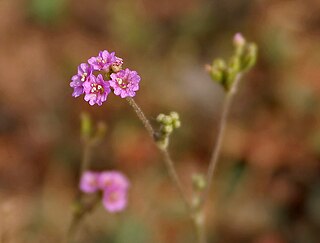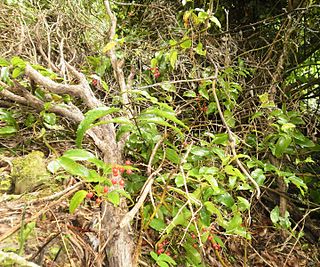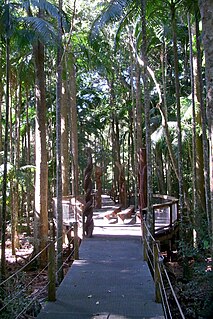See also
- Supplejack Downs, also Suplejack Downs, a pastoral lease in Australia
Supplejack is a common name for several plants and may refer to:

A vine is any plant with a growth habit of trailing or scandent stems, lianas or runners. The word vine can also refer to such stems or runners themselves, for instance, when used in wicker work.

Toxicodendron is a genus of flowering plants in the sumac family, Anacardiaceae. It contains trees, shrubs and woody vines, including poison ivy, poison oak, and the lacquer tree. All members of the genus produce the skin-irritating oil urushiol, which can cause a severe allergic reaction. The generic name is derived from the Greek words τοξικός (toxikos), meaning "poison," and δένδρον (dendron), meaning "tree". The best known members of the genus in North America are poison ivy (T. radicans), practically ubiquitous throughout most of eastern North America, and western poison oak, similarly ubiquitous throughout much of the western part of the continent.
Cypress is a common name for various coniferous trees or shrubs of northern temperate regions that belong to the family Cupressaceae. The word cypress is derived from Old French cipres, which was imported from Latin cypressus, the latinisation of the Greek κυπάρισσος (kyparissos). Cypress trees are a large classification of conifers, encompassing the trees and shrubs from the cypress family (Cupressaceae) and many others with the word “cypress” in their common name. Many cypress trees have needle-like, evergreen foliage and acorn-like seed cones.

Anthurium is a genus of about 1,000 species of flowering plants, the largest genus of the arum family, Araceae. General common names include anthurium, tailflower, flamingo flower, and laceleaf.

Fallopia is a genus of about 12 species of flowering plants in the buckwheat family, often included in a wider treatment of the related genus Polygonum in the past, and previously including Reynoutria. The genus is native to temperate and subtropical regions of the Northern Hemisphere, but species have been introduced elsewhere. The genus includes species forming vines and shrubs.
Dogwood is a common name for trees and shrubs in the temperate Northern Hemisphere genus Cornus.

Berchemia scandens, commonly called Alabama supplejack, is a species of climbing plant in the buckthorn family. It is native to the central and southern parts of the United States. It is found in a wide variety of habitats, including swamps, bottomlands, riparian banks, and upland calcareous areas.
Wait-a-while may refer to:

Ripogonum is a genus of flowering plants confined to eastern Australia, New Zealand, and New Guinea. Until recently this genus was included in the family Smilacaceae, and earlier in the family Liliaceae, but it has now been separated as its own family Ripogonaceae.
Cat's claw or cat's claws is a common name for several plants:

Ventilago viminalis, commonly known as supplejack, vine tree or whip vine, is a tree native to Northern and Central Australia from coastal regions of Queensland to the Northern Territory and Western Australia.

Hibbertia scandens, sometimes known by the common names snake vine, climbing guinea flower and golden guinea vine, is a species of flowering plant in the family Dilleniaceae and is endemic to eastern Australia. It is climber or scrambler with lance-shaped or egg-shaped leaves with the narrower end towards the base, and yellow flowers with more than thirty stamens arranged around between three and seven glabrous carpels.

Boerhavia is a genus of over 100 species in the Nyctaginaceae family. The genus was named for Herman Boerhaave, a Dutch botanist, and the genus name is frequently misspelled "Boerhaavia". Common names include spiderlings and hogweeds.

Celastrus scandens, commonly called American bittersweet or bittersweet, is a species of Celastrus that blooms mostly in June and is commonly found on rich, well-drained soils of woodlands. It is a sturdy perennial vine that may have twining, woody stems that are 30 feet (9.1 m) or longer and an inch or more thick at the base. The stems are yellowish-green to brown and wind around other vegetation, sometimes killing saplings by restricting further growth. It has tiny, scentless flowers at the tips of the branches. It has colorful, orange fruits that are the size of a pea. These fruits are poisonous to humans when ingested, but are favorites of birds. C. scandens roots were used by Native Americans and pioneers to induce vomiting, to treat venereal disease, and to treat symptoms of tuberculosis.

The Kimberley tropical savanna is a tropical and subtropical grasslands, savannas, and shrublands ecoregion in northwestern Australia, covering portions of Western Australia and the Northern Territory south of the Timor Sea.
H. scandens may refer to:

Ripogonum scandens, is a common rainforest vine native to New Zealand. It can also grow in areas of swamp.

The Sea Acres National Park is a national park that is located in the Mid North Coast region of New South Wales, in eastern Australia. The 76-hectare (190-acre) park is situated near the town of Port Macquarie. The park is a popular tourist area with a 1.3-kilometre (0.81 mi) long boardwalk through a remnant of seaside rainforest. There is also an education centre and cafe. The park was initially declared as a nature reserve in 1987; and gazetted as a national park in October 2010.

Mikania scandens is a species of flowering plant in the family Asteraceae. Its common names include climbing hempvine, climbing hempweed, and louse-plaster. It is native to the eastern and central United States, with its distribution extending into Tamaulipas, Mexico. Reports of its presence in Ontario, Canada are erroneous. It is an introduced and invasive species on many Pacific Islands and in parts of southern Asia.
Plants with the common name snake vine include: